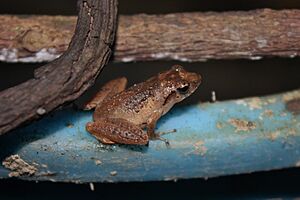Romer's tree frog facts for kids
Quick facts for kids Romer's tree frog |
|
|---|---|
 |
|
| Conservation status | |
| Scientific classification | |
| Genus: |
Liuixalus
|
| Species: |
romeri
|
| Synonyms | |
|
Philautus romeri Smith, 1953 |
|
The Romer's tree frog (Liuixalus romeri) is a tiny frog that lives in Hong Kong and a small part of Guangxi, China. It is the smallest amphibian (an animal that lives both on land and in water) found in Hong Kong. This frog is only about 1.5 to 2.5 centimeters long, measured from its snout (nose) to its vent (tail end). Even though it's called a "tree frog," it belongs to a different frog family called Rhacophoridae, not the Hylidae family that most tree frogs belong to.
Contents
What Does Romer's Tree Frog Look Like?
Female Romer's tree frogs are a little bigger than the males. Their bodies are tan-brown on top and white underneath.
Special Markings
You can often see an X-like shape on their back. This shape is made of two wiggly black lines. Sometimes, these lines don't quite meet, making a V-shape instead. Below this X or V, there's often another V-shape that looks upside down. Their skin feels a bit bumpy, like it's covered in tiny grains. A clear fold of skin runs from their eye down to their front leg.
Head and Legs
Romer's tree frog has a snout that is triangular but not sharp. Its lips have small brown spots. Between its eyes, there's a dark bar that goes onto its eyelids. Its back legs are long and thin, with irregular brown or black stripes across them. All of its fingers and toes have small sticky pads. These pads help the frog hold onto tree branches or leaves.
Where Do Romer's Tree Frogs Live?
Romer's tree frogs like to live in areas with lots of trees. They need small streams or other water sources nearby for breeding. These frogs usually sit on low bushes, hide in fallen leaves, or rest on the ground.
Known Locations
In Hong Kong, these frogs have only been found on four islands: Lantau Island, Lamma Island, Po Toi Island, and Chek Lap Kok. In 2007, they were also found in Guangxi, China. This was a surprise because it's quite far from the Hong Kong frogs.
Life Cycle and Habits
Romer's tree frogs are active only at night. They live for about three years in the wild. However, female frogs can only lay eggs during two breeding seasons.
Breeding and Tadpoles
The frog breeds in shallow water from early March to September. Male frogs make a loud, quick call. The female frog lays up to 120 eggs. She glues them onto plants, stones, or other things that are underwater.
The eggs and tadpoles (baby frogs) are in danger from a fish called the mosquitofish. This fish eats them. So, Romer's tree frogs can only breed in places where mosquitofish are not present. The tadpoles are brown and take about 4 to 6 weeks to change into adult frogs in a controlled environment.
What Do They Eat?
Adult Romer's tree frogs eat small insects like termites and crickets. They also eat spiders.
Discovery and Protecting Romer's Tree Frog
The Romer's tree frog was named after John D. Romer. He first found it in a cave on Lamma Island in 1952. Sadly, the frogs in that cave disappeared in 1953 when the cave collapsed. People thought the frog was gone forever, but it was found again on Lamma Island in 1984.
Rescue and Relocation
In 1992, over 200 Romer's tree frogs were saved from Chek Lap Kok. This was before the new Hong Kong International Airport was built there. These rescued frogs were bred successfully. Their young were then released into eight special places on Hong Kong Island and in the New Territories. The frogs survived in seven of these new locations. Surprisingly, a very small number also managed to survive in Chek Lap Kok itself!
Conservation Efforts
Romer's tree frog is an endangered species. It is protected by law in Hong Kong under the Wild Animals Protection Ordinance (Cap. 170). A part of Ngong Ping in Lantau Island has the largest group of these frogs. This area was made a Site of Special Scientific Interest in May 1999 to help protect them.


